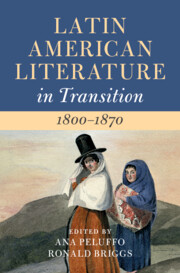Book contents
- Latin American Literature in Transition 1800–1870
- Latin American Literature in Transition
- Latin American Literature in Transition 1800–1870
- Copyright page
- Contents
- Figures
- Contributors
- Acknowledgments
- Introduction
- Part I Aesthetics of Disorder
- Part II Affective Communities
- Part III Intersectional Subjectivities
- Chapter 15 Shame, Enslavement, and Identity
- Chapter 16 Narratives from Enslavement
- Chapter 17 Masculinities and Racial Ambivalence
- Chapter 18 Childhood, Race, and Gender
- Chapter 19 Uncle Tom’s Cabin in Brazil
- Part IV Transoceanic Consciousness
- Index
- References
Chapter 17 - Masculinities and Racial Ambivalence
from Part III - Intersectional Subjectivities
Published online by Cambridge University Press: 24 January 2023
- Latin American Literature in Transition 1800–1870
- Latin American Literature in Transition
- Latin American Literature in Transition 1800–1870
- Copyright page
- Contents
- Figures
- Contributors
- Acknowledgments
- Introduction
- Part I Aesthetics of Disorder
- Part II Affective Communities
- Part III Intersectional Subjectivities
- Chapter 15 Shame, Enslavement, and Identity
- Chapter 16 Narratives from Enslavement
- Chapter 17 Masculinities and Racial Ambivalence
- Chapter 18 Childhood, Race, and Gender
- Chapter 19 Uncle Tom’s Cabin in Brazil
- Part IV Transoceanic Consciousness
- Index
- References
Summary
This chapter explores the tensions, contradictions, and transformations in the cultural and discursive construction of two figures in nineteenth-century literary and popular cultural representations.
- Type
- Chapter
- Information
- Latin American Literature in Transition 1800–1870 , pp. 265 - 279Publisher: Cambridge University PressPrint publication year: 2022



